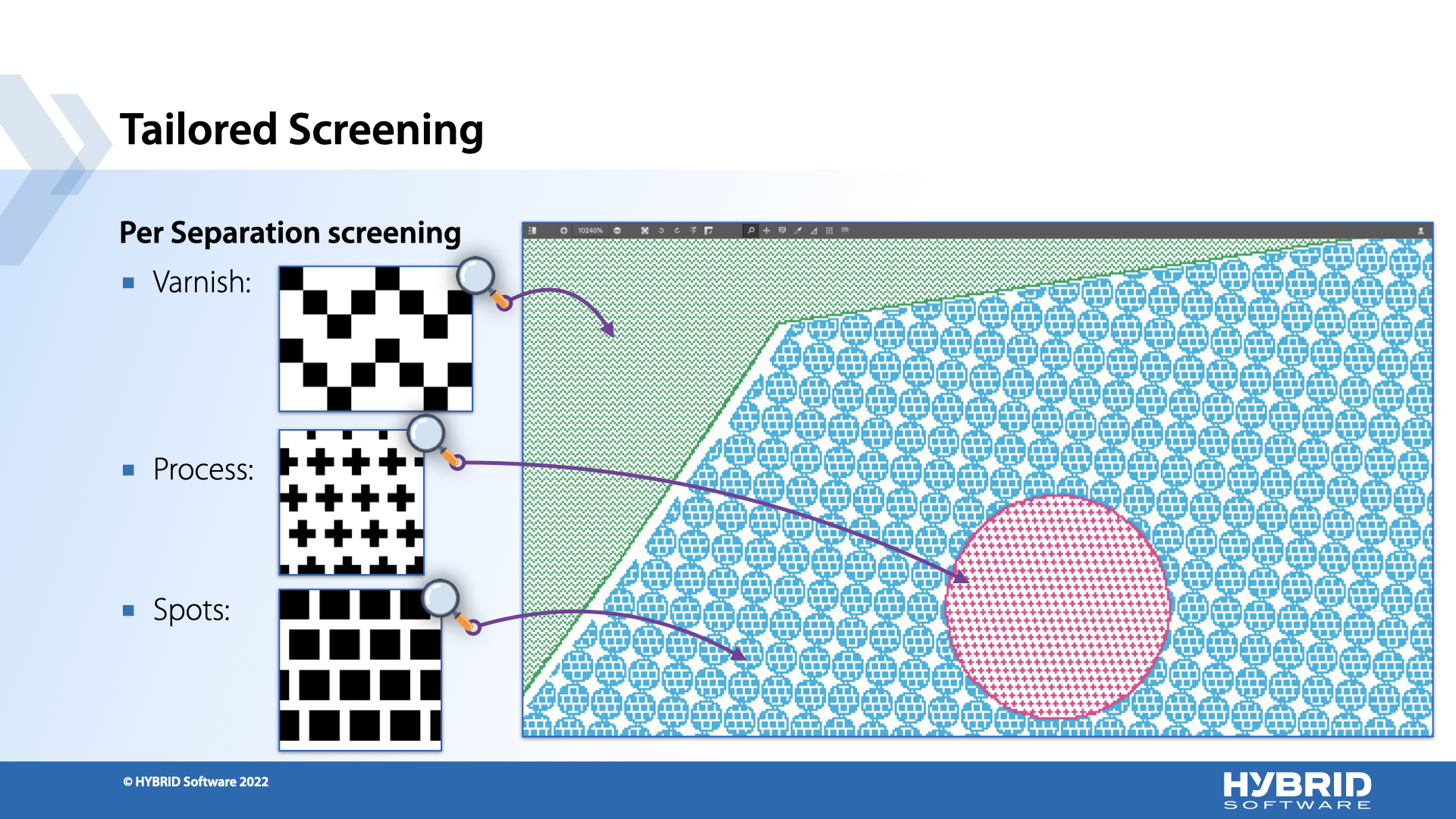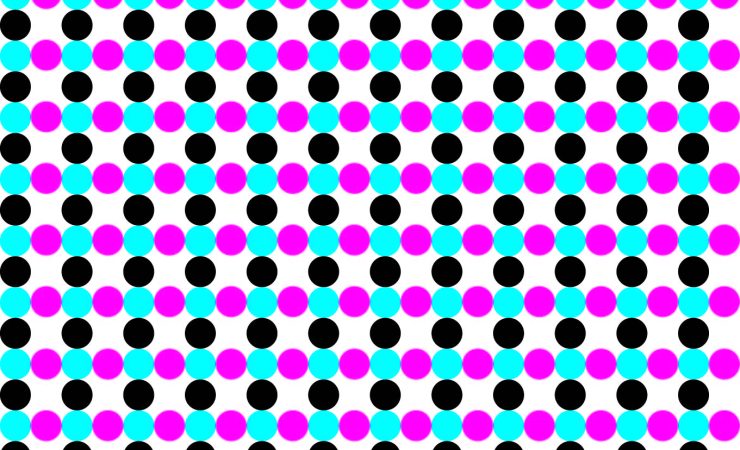Screening is a vital part of the print production process and printers underestimate it at their peril. Charlie Kortens investigates
Screening is the technique employed in the printing process to simulate shades of grey (tone) or colour and reproduce photographs using combinations of dots from a limited number of coloured inks,’ said Pierre Hammond, commercial director at Hamillroad Software when asked to explain the process in the ‘simplest possible terms.’
‘It is necessary because printing presses are practically limited to printing solid areas of ink with a fixed number of pigmented process colour inks, normally cyan, magenta, yellow and black (CMYK). Black ink is used to produce a darker result than the often grey-looking colour produced when mixing cyan, magenta and yellow inks, as well as being a lot cheaper. More expensive custom ‘spot colour’ inks are also commonly used to reproduce particular brand colours that are difficult to simulate using just CMYK, or those that don’t print well.
‘Where a larger tonal range is required than can be simulated with just CMYK, Expanded Colour Gamut (ECG), or Expanded Gamut Printing (EGP) techniques may be used.
Here typically seven different inks are used, adding Orange, Green and Violet (OGV) to the existing CMYK set; these additional inks increase the colour gamut of what can be printed accurately.
‘Many types of screening have been developed employing different strategies or techniques for how the dots are shaped, sized and positioned relative to each other which results in different characteristics, each with specific advantages and potential problems, some of which are extremely serious.’
Varieties
Of course, when it comes to screening there are different ways of doing things, depending on a printer’s circumstances. As Robert Bruce, Esko’s product manager for flexo software, explains, ‘When looking at the basics of flexo screening, there are really five key factors to consider. The first is the imaging resolution, which is determined by the spot or pixel size of the imaging device. The resolution determines the number of pixels available for an individual dot, with the most common being 2540 dpi.
‘There is an obvious correlation between imaging resolution and the second key factor, screen ruling. Screen ruling is determining print quality, in that the higher the resolution, the more defined images are, leading to a superior quality final print.
‘The third factor is the dot shape. There are numerous dot shapes available to the flexo printer such as circular, Euclidean, square, elliptical, or even rugby ball shaped. Different dot types can be linked to the imaging device and are sometimes favoured when printing on different substrates, like the age-old film versus paper debate.
‘The type of screen itself is the next key factor. Amplitude Modulation screening, or AM, is a common type of screening used throughout the industry. It enables the use of a multitude of dot shapes which, when printed flexographically, typically appear very smooth to the naked eye. Less common is Frequency Modulated screening – or FM. With
FM screening, the dot size of the screen remains the same, whilst the frequency varies to create different tonal values. While FM screening can be created at a higher line count compared to AM screening, they can have a visible ‘grainy’ appearance once printed. Today, the most common screen type is actually a combination of both AM and FM processes to achieve a desired look. Known as transitional screening, this involves the blending of AM into FM screening in the highlights and shadows, commonly used to make images have a natural fade to zero or to 100%, without the customary ‘hard edge’ associated with flexo printing.
‘Finally, there is surface screening, which as the name suggests adds a surface pattern to the printing dot on the final flexo plate. This process is used to improve ink laydown on film substrates which suffer from reticulation, to improve colour saturation. There are different types of surface screening, which can be applied to both solid and halftone areas. The type of surface screening is dictated by variables such as the ink, substrate, anilox volume and plate type being used, with different screens being required for flexible packaging, labels and corrugated applications.’

Intelligent Flexo is Hybrid Software’s surface screening module for improving flexo quality
Options
That’s the general idea, but when it comes to specific solutions, ‘Hybrid Software has always looked to develop technology that can help mitigate the inherent problems associated with the flexo printing process,’ says Paul Bates, the company’s sales manager. ‘Packz, Hybrid’s PDF editor, has the ability to apply different Flexo screening technology to different objects within a PDF, this allows operators to send a file to a RIP and apply different screening technologies such as AM, FM or even Hybrid screening (excuse the pun) to different objects within the prepress file to get the best results on press. However, when it comes to surface screening, we wanted to automate the process with artificial intelligence allowing Cloudflow to identify problematic areas that need enhancing.
Control Wizard, a software option which the company says it designed specifically because there are ‘so many variables and parameters to take into account,’ and as part of a deliberate mission to simplify the flexo plate making process and improve flexographic print quality via crystal screens. The company adds that, ‘Flexible packaging converters and label printers use Print Control Wizard for a simplified, standardised approach to take process parameters like ink, printing press, substrate and anilox into consideration for screen and curve creation, outputting a set of Crystal Screens and curves used for plate exposure on a CDI Crystal XPS, resulting in the most optimal flexo print quality.’
Hamillroad’s star offering is Bellissima DMS, a digitally modulated (DM) screening product which includes all hardware and software as well as technical support for quick implementation at customer sites. The company describes DM as a ‘new approach that combines the best characteristics of AM and FM in a single screen, without dragging along the negatives.’
‘Meanwhile Intelligent Flexo is Hybrid Software’s surface screening module for improving Flexo quality by allowing prepress providers, tradeshops and printers to apply micro cell patterns to their RIPped data. The unique points to note are that Intelligent Flexo is an agnostic and flexible solution, meaning you can create your own custom patterns and apply these to TIFF/LEN files from any RIP, send them to any CTP, and use any plate. There is no one-size fits all solution when it comes to enhancing the quality of your flexo output, and this is where Intelligent Flexo really shines. As the name implies, Intelligent Flexo can automatically detect specific regions of graphical content and apply specific treatment only to those.’
It adds that Bellissima, ‘enables printers to produce gravure matching ultra-high fidelity print while being easy to plate and stable on press at the same time. It lets printers compete effectively for gravure to flexo conversion jobs.’
Bellissima is compatible with plates from multiple vendors, and is intended to make it easier for printers to implement fixed palette and ECG across all jobs.
Predictions
In such a technical, precise and scientific sector, it isn’t always easy to predict what the future might hold, but Mr Hammond certainly had a go. ‘Globally printers are under pressure from the trend towards shorter runs and faster turnround times enabled by digital printing,’ he said. ‘That together with ongoing cost reductions in digital printing, is shrinking conventional printers’ addressable market as the cost breakeven point between digital and flexo tends to an ever-higher number of impressions.
‘Cost savings from reducing waste and increasing efficiency are critical to all businesses and increasing pressroom efficiency and effective press capacity are significant factors that will allow printers to continue to operate profitably. We see a resurgence of interest from printers re-visiting fixed palette CMYK and ECG printing to enable them to cope with the change to shorter run lengths.
‘Brand owners in turn are being driven to be more environmentally friendly and are aware of the sustainability and eco-benefits of flexo and fixed palette ECG printing versus their traditional print methods and are looking to the supply chain for this capability. They are however unwilling to sacrifice print fidelity compared to gravure printing using spot colours and wish to benefit from the lower costs of flexo printing.
‘Screening is key to ensure that both parties’ needs are met; the printer benefits from stable, Ultra HD print production at a reduced cost, while brand owners achieve gravure like quality with brand spot colours perfectly reproduced with a fixed palette/ ECG set of process inks.
‘Highly advanced flexo screening technology, coupled with advanced plate-making technology, is advancing the industry and giving longer life to flexo.’






